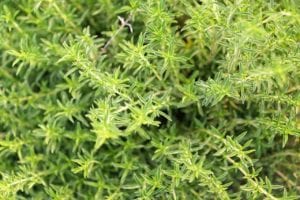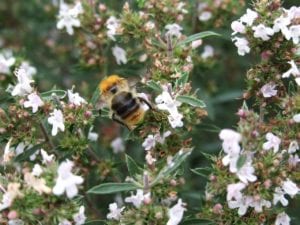During winter I find myself experimenting with new recipes, many of which can be cooked in one pot on the stove, and I’m always looking for ways to add as many fresh ingredients as I can. Fresh herbs are one of the best ways to add a lot of flavor in an easy, healthy way. I have recently been turned on to the herb winter savory and have decided that this often overlooked herb needs some time in the spotlight today.




Winter Savory in Fall and Winter Herb Gardens in San Antonio, Texas
Winter savory is the perfect herb for our fall and winter seasons (it has some great pollinator benefits in springtime too). At first glance, winter savory could possibly be mistaken for the herb rosemary. Both of these herbs have small, needle-like, dark-green, evergreen leaves; but winter savory only grows about 1 foot high, its leaves are softer than the leaves on rosemary and they lack the waxy feel.
The taste of winter savory is comparable to the taste of fresh peppercorns. The strong spicy flavor lends well in soups, stuffings, and marinades. Winter savory is a great mixing herb, meaning that it blends well with other herbs. You could chop up a bunch of herbs from your garden and make a simple herb cheese roll, or mix in some winter savory and Mexican mint marigold (our favorite substitute for tarragon) into a chicken salad recipe. Just keep in mind that whenever you add winter savory to your cooking, due to its spicy flavor, you may want to dial back any pepper that is also included in the recipe. You can always add extra pepper at the end if needed.
Winter savory is very winter hardy and can tolerate temperatures as low as -10°F. It’s not likely that we would see those temperatures during our winters, but it’s nice to know your winter savory will be just fine here in San Antonio. Winter savory should be planted in an area that receives at least 6-7 hours of full sun, and like most herbs, it needs well-draining soil. This herb performs and looks great in both front borders and containers. Planting winter savory above spring and summer bulbs is a great idea. You’ll enjoy the flowering bulbs that pop out through the winter savory in spring and summer and when they die back, winter savory is there to fill back in the space.
The most tender, new growth and fresh side shoots on stems of winter savory have the best flavor and should be used for culinary purposes. Cutting winter savory back to the ground a couple of times during the year (early spring and fall) produces lush tender growth. When winter savory is left to grow without any cutting back it will get woody and unappetizing, however, it will produce attractive clouds of white flowers that the bees absolutely adore. If you haven’t picked up on my opinion about herbs yet, here it is again. Plant one herb for you to use in the kitchen that you harvest from often, and one herb that you allow to flower and go to seed to treat the native pollinators! It’s a win-win situation.
Are you ready to try winter savory in your herb gardens this winter? We don’t think you will be disappointed!
~The Happy Gardener, Lisa Mulroy


Winter herbs are amazing!
They definitely are!